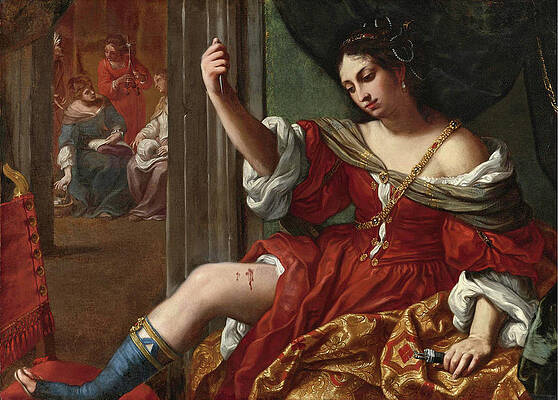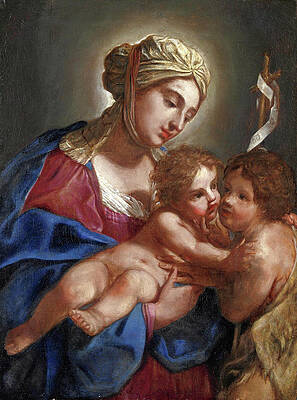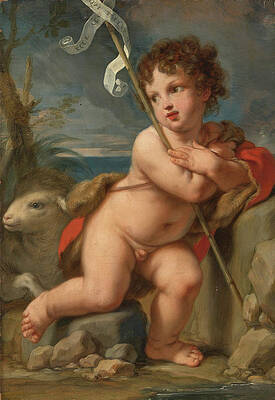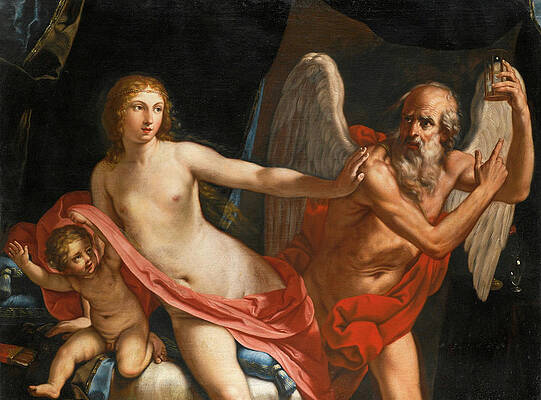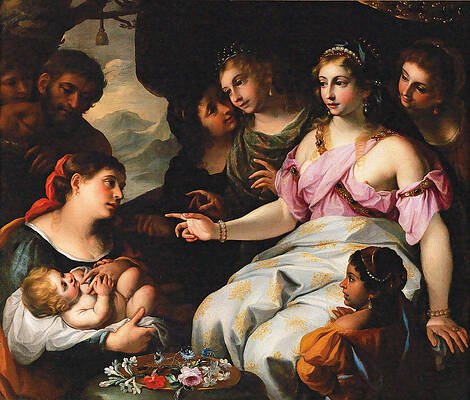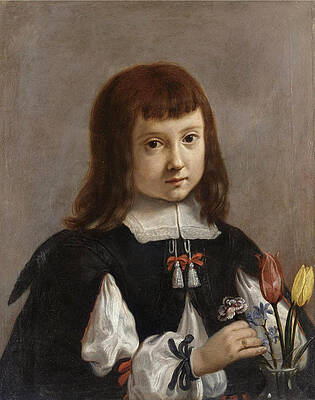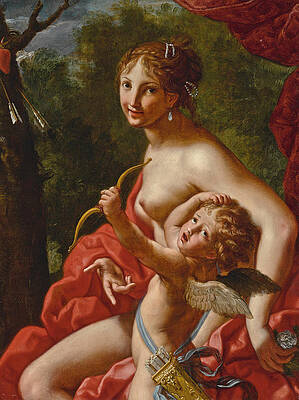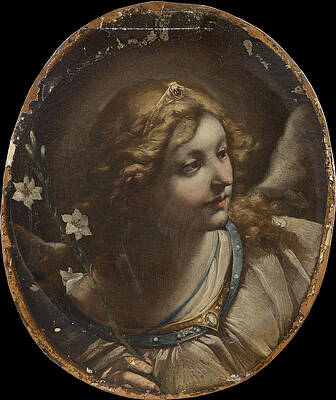Elisabetta Sirani
Paintings
Judith with the Head of Holofernes
Madonna and Child with Saint John
Young Saint John the Baptist
Beauty fending off Time
The Finding of Moses
Portrait of a Young Boy, half Length, arranging Flowers in a Vase
Venus and Cupid
Head of the Virgin
Head of an Angel
Self-portrait
Elisabetta Sirani (8 January 1638 – 28 August 1665) was an Italian Baroque painter and printmaker who died in still-unexplained circumstances at the early age of 27.[1] She was the most famous woman artist in early modern Bologna and established an academy for other women artists.[2]
Life
Elisabetta Sirani was born in Bologna in January 1638, the first of four children of Margherita and Giovanni Andrea Sirani. She was trained by her father, a painter of the School of Bologna, who was a pupil of Guido Reni and an art merchant. Her biography is included in Carlo Cesare Malvasia’s two-volume Felsina pittrice: vite de’pittori bolognesi, or Lives of the Bolognese Painters, first published in 1678.[3] Malvasia was personally acquainted with the Sirani family and actually took credit for recognizing Elisabetta’s talent and persuading her father to train her as an artist, although this was likely self-aggrandizing.[4] Throughout his biography of Sirani, Malvasia praises the originality of her compositions, her style of drawing, her fast manner of working, and her professionalism, contrasting her with Lavinia Fontana, an earlier Bolognese woman painter whom he describes as timid.[5] Giovanni Andrea Sirani became incapacitated by gout later in his career and Elisabetta began running her family's workshop by 1654.[6] Her studio was incredibly successful, likely due to the progressive atmosphere of Bologna, where women artists were more welcome and celebrated.[7] She trained a number of men and women artists, including her younger sisters Barbara and Anna Maria and a least 12 other young women.[8]
Sirani died suddenly in August 1665, in Bologna. Her death was considered suspicious and a maidservant, Lucia Tolomelli, was charged with poisoning the artist and put on trial, but Giovanni Andrea Sirani withdrew the charges.[9] Malvasia attributed her death to love-sickness because Sirani never married.[10] Her actual cause of death was most likely the onset of peritonitis after a ruptured peptic ulcer.[11] Sirani was given an elaborate funeral which included an enormous catafalque with a life-sized sculpture of the artist (illustrated in Malvasia's biography), orations and music composed in her honor, and she was buried in the Basilica of San Domenico, Bologna, in the same tomb as her father's teacher, Guido Reni.[12]
Portia Wounding Her Thigh, 1664 at Collezioni d'Arte e di Storia della Fondazione Carisbo, Bologna
Works
Elisabetta Sirani produced over 200 paintings, 15 etchings, and hundreds of drawings, making her an extremely prolific artist, especially considering her early death.[13] Sirani kept a list of her paintings and who commissioned them beginning in 1655, which is recorded in Malvasia’s biography and many of her paintings are signed.[14] Her works cover a number of subjects, including historical and Biblical narratives, often featuring women, allegories, and portraits. She painted at least 13 public altarpieces, including The Baptism of Christ at the Certosa di Bologna of 1658.[15] Around 1660, she began focusing extensively on small-scale devotional images, particularly Virgin and Child and Holy Family, which were enormously popular with private collectors.[16] Her patrons ranged from cardinals to kings, princes, dukes, merchants, and academics from Bologna and across Europe.[17] Sirani became a celebrity in her city as visitors, such as diplomats, political leaders, and noblemen, would come to her studio to watch her work.[18]
Sirani’s style is close to that of her father’s teacher, Guido Reni, but Elisabetta employed more dramatic contrasts of light and shade, virtuoso brushstrokes, and more brilliant color.[19] Her striking images of female heroines, such as Portia Wounding Her Thigh are comparable to the work of Artemisia Gentileschi. Sirani often selected lesser-known subjects for her paintings and her unique interpretation of iconography drew praise from a number of contemporaries.[20] Her drawings, usually in pen or brush and ink display the same brilliance as her paintings, often quickly executed with what Malvasia describes as "nonchalance."[21]
Virgin and Child, 1663 at National Museum of Women in the Arts, Washington, DC
In popular culture
Sirani is referenced in Judy Chicago's The Dinner Party[22]
In 1994, a crater on the planet Venus was named after Sirani.[23]
Sirani's painting Virgin and Child of 1663, now in the collection of the National Museum of Women in the Arts in Washington, DC, was selected for the United States Postal Service Christmas Holiday Stamp series in October 1994.[24] This was the first work by a woman artist chosen for the series.
Her Herodias with the Head of John the Baptist is featured on the cover of the Canadian technical death metal band Cryptopsy's 1996 album None So Vile.
Gallery
Allegory of Music
Beatrice Cenci, generally ascribed to Guido Reni, which inspired Percy Shelley's play The Cenci
Judith with the Head of Holofernes
Virgin and Child, ink and wash on paper
Allegory of Justice, Charity, and Prudence
References and Sources
References
Malvasia 1678, Vol II, 453–467.
Modesti, 1-2
An English translation of the 1841 edition is provided in Dabbs, 121-32.
Dabbs, 121.
Malvasia 1678, Vol II, 453 and Dabbs 122.
Modesti, 1.
Artist Profile: Elisabetta Sirani.
Modesti, 67-79.
Malvasia 1678, Vol II, 479 and Dabbs, 131.
Malvasia 1678, Vol II, 479-80 and Dabbs, 123.
Moedsti, 1
Malvasia 1678, Vol II, 463. Malvasia also reproduces a number of the orations throughout his text.
Modesti records a number of the paintings, prints, and drawings in her catalogue.
Malvasia 1678, Vol II, 467-76 and Italian Women Artists, 241.
Modesti, 5.
Italian Women Artists, 241.
Modesti, 4.
Modesti, 15.
Italian Women Artists, 241-48.
Modesti, 5.
Italian Women Artists, 242 and Bohn, 207-36.
"The Dinner Party". Brooklyn Museum. Retrieved 8 March 2015.
"Sirani". Gazetteer of Planetary Nomenclature. International Astronomical Union (IAU) Working Group for Planetary System Nomenclature (WGPSN). Retrieved 8 March 2015.
"Christmas Holiday Stamps". United States Postal Service: Our History. United States Postal Service. Retrieved 8 March 2015.
Sources
Artist Profile: Elisabetta Sirani''. National Museum of Women in the Arts.
Bohn, Babette. "Elisabetta Sirani and drawing practices in early modern Bologna," Master Drawings, vol. 42, no. 3 (Autumn 2004): 207–236.
Frick, Carole Collier et al. Italian Women Artists: From Renaissance to Baroque. New York: Rizzoli, 2007. Catalog of an exhibition held at the National Museum of Women in the Arts, Washington, D.C. ISBN 9788876249198
Dabbs, Julia K. Life Stories of Women Artists, 1550-1800: An Anthology. Burlington, VT: Ashgate, 2009, 121–132. ISBN 9780754654315
Malvasia, Carlo Cesare. "Di Gio. Andrea Sirani e di Elisabetta sua figlivola", Felsina pittrice, vité de pittori bolognesi (2 vols, Bologna, 1678), vol. II, 453–487. Digital Edition: http://catalog.hathitrust.org/Record/000461733.
Modesti, Adelina. Elisabetta Sirani 'Virtuosa' Women's Cultural Production in Early Modern Bologna. Turnhout, Belgium: Brepols, 2014. ISBN 9782503535845
Further reading
Ottavio Mazzoni Toselli, Di Elisabetta Sirani pittrice bolognese e del supposto veneficio onde credesi morta nell’ anno XXVII di sua età. Bologna, 1833.
Laura M. Ragg. The Women Artists of Bologna. London, 1907, 229–308.
Germaine Greer, The Obstacle Race: The Fortunes of Women Painters and Their Work. London, 1979, 218–220.
Babette Bohn, "The Antique Heroines of Elisabetta Sirani," Renaissance Studies, vol. 16, no. 1 (March 2002): 52-79.
Babette Bohn, "Female self-portraiture in early modern Bologna", Renaissance Studies, vol. 18, no. 2 (June 2004): 239–286.
Jadranka Bentini and Vera Fortunati Pietrantonio. Elisabetta Sirani. Pittrice eroina, 1638-1665. Bologna: Editrice Compositori, 2004. ISBN 8877944668
Adelina Modesti. Elisabetta Sirani: una virtuosa del Seicento bolognese. Bologna: Editrice Compositori, 2004. ISBN 8877944455.
Artist
A - B - C - D - E - F - G - H - I - J - K - L - M -
N - O - P - Q - R - S - T - U - V - W - X - Y - Z
Retrieved from "http://en.wikipedia.org/"
All text is available under the terms of the GNU Free Documentation License


